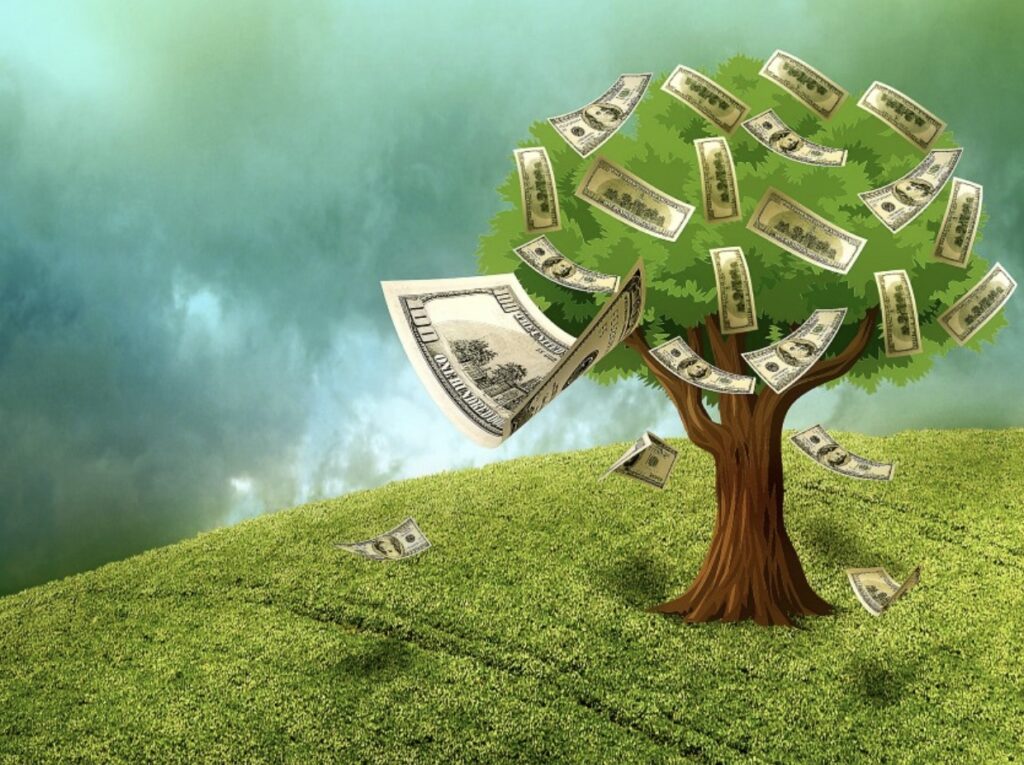I was recently attending the Building Bridges Sustainable Finance event in Geneva, where the European Launch of the TNFD (Taskforce for Nature-related Financial Disclosures) was taking place. I’ve been watching the TNFD unfold over the past few years, and thought it’s still in its infancy, its principles are strong. Having the benefit of not being the first framework for ESG management and sustainability disclosures, one of its greatest strengths is its interoperability with other frameworks, like the TCFD, GRI and IFRS S1.
If you are a forest investor/asset manager, I would encourage you to familiarize yourself with the TNFD recommendations. In my view, they are not just another reporting standard, but can serve you as an excellent management tool. In this week’s article, I’m going to focus on one aspect of TNFD that I find to be particularly relevant to forest investment, and that is the topic of Double Materiality.

What is Double Materiality?
In a past article on the new ISSB sustainability standards, I wrote about materiality – that is where information is considered to be material if omitting, misstating, or obscuring information could reasonably be expected to influence decisions on the basis of those sustainability-related financial reports. What this means is that a certain ESG outcome will positively (opportunity) or negatively (risk) impact the financial performance of the investment.
What then is Double materiality?
Double materiality additionally looks at the ESG performance spurring from the investment activity itself. In the Building Bridges event, a panelist on the TNFD launch from Holcim, a company working towards innovative and sustainable building solutions, did a great job of explaining the double materiality concept as it relates to biodiversity. Renata Pollini explained that at Holcim, when referring to their cement production, simply described that this part of their business is not dependent on biodiversity, but it impacts biodiversity. On further digging into their most recent sustainability report, quarries represent their material threat to biodiversity – and as such, they have developed KPIs and management systems around quarry rehabilitation for biodiversity. Simple, yet effective.
Thus, double materiality in investment considers both:
- The impact on financial performance from an ESG outcome, and,
- The ESG impact from investment activities.
In both cases above, TNFD provides the framework for disclosing entities to consider both positive and negative materiality as related to nature: that is impacts to and from land, freshwater, ocean and atmosphere.
Double Materiality in the TNFD Framework
Like TCFD, TNFD recommends organizations to disclose on 4 pillars of business/investment management:
- Governance
- Strategy
- Risk and Impact Management, and
- Metrics and Targets
Through recommending 14 disclosures within these four pillars, TNFD guides organizations to look at nature-related materiality through:
- Dependencies – of the organization on nature
- Impacts – on nature, caused or contributed to by the organization
- Risks – to the organization stemming from their dependencies and impacts, and
- Opportunities – for the organization that benefit nature through positive impacts or mitigation of negative impacts on nature.
You can view all 14 of the TNFD Disclosures in the Recommendations.
Double Materiality in Forest Investment
There is no shortage of guidance on materiality assessments, like the SBTN Sectoral Materiality Tool. However, if you’re just starting out – this is a daunting place to start. Below I’m going to provide a simplistic starting assessment – that practically considers the dependencies (financial performance related to nature) and impacts (impact on nature from your investment activities) for forest investment.
Dependencies (Nature’s impact on financial performance)
The financial performance of a forest investment depends on the asset’s ability to deliver forest goods and services with an economic value. These may include: timber and other wood or fiber products, watershed services (community water access), recreation (ex. Hunting or fishing rights), carbon and biodiversity credits. The mix of goods and services provided will be specific to your investments. Given the above goods and services, a forest investment could be seen to have the following dependencies on nature:
Dependence on soil and water integrity to support growth of healthy, productive forests
- Where soil and water integrity are optimal – with sufficient water and soil nutrients and soil stability, trees will grow predictably in a healthy way and support production of forest products in line with your growth and yield models.
- On the down-side if soil and water integrity are not maintained, you may suffer the chronic effects of poor nutrients and inadequate water – giving way to forest health issues and poor forest productivity and a negative impact on returns. You may suffer an acute catastrophic loss in the event of a landslide which can impact both the forest asset, forest infrastructure (roads, bridges and facilities), and may experience financial penalties if your operation is deemed responsible for the damage.
Dependence on biodiversity to support long-term resilience and health of the forest
- Forests with high levels of biodiversity in terms of species abundance, genetic variability, and ecosystem variability can support your investment’s ability to recover from shocks to the forest ecosystem – like fire, drought, etc, and also make your forests more attractive to markets and successor investors that value biodiversity. Related to this, if you are targeting biodiversity markets or carbon markets with co-benefits – biodiversity protection and enhancement will support your biodiversity return drivers.
- Your returns are reliant on a healthy and productive forest, all of which can be negatively impacted with biodiversity loss. Consequences of biodiversity loss include loss of pollination and other symbiotic relationships across different species, and resistance to pests and diseases that target single species, and loss of market access where investors and markets value biodiversity in their pricing.
Dependence on climate stability to support long-term resilient and healthy forests
- This is one of the simplest metrics to articulate – Where strong financial performance is dependent on a stable climate. That is, regular rainfall and seasonal weather patterns especially if your investments focus on growing new or young forests – where the trees are more sensitive to shocks.
- In the absence of climate stability, your investments are at risk of suffering from acute climate shocks, such as storms, floods and wildfire and chronic climate change, such as prolonged drought or seasonal climatic abnormalities.
Impacts (Investment activities’ impacts on Nature)
The forestry sector without a doubt, has a direct impact on nature. This may be positive or negative – let’s take a look at the primary forest ecosystem dependencies that drive financial materiality to understand impact materiality – of soil and water integrity, biodiversity and climate stability.
Investments into forest management can support or detract soil and water integrity
- Through the development of roots, reforestation/afforestation can improve soil stability, prevent erostion and decrease desertification and improve nutrient cycling through different layers of soil. Depending on the soil nutrients of the site and the species selected, afforestation/reforestation can either deplete soils or act as a natural fertilizer. An example of the natural fertilizer effects of older forests are mycorrhizal fungi – a relationship between the fine roots of trees and a fungus that helps improve access to nutrients and water, helps in seedling establishment, protects against pests and root pathogens, fosters resilience against environmental stress and climate change, maintains structural and species diversity.
- Depending on the site’s soil and hydrological characteristics –investments into poorly designed forest management can contribute to soil nutrients and water depletion (for example, planting a drought intolerant species on a dry site, or large clear cuts on sites with weak soil structures that are prone to erosion or land slides in the cases of steep slopes). Forest management operations may pollute soil and water – if fuels or fertilizers enter into soils and water ways. Poorly designed forest infrastructure, such as roads and bridges may contribute to the re-routing of natural water ways – leading to erosion and landslides.
Investments into forest management can support or detract from biodiversity of the forest
- On degraded sites, investments into forest management that support multiple tree species at different age classes can encourage other native species of undergrowth, that contribute to the presence of different wildlife, and ecosystem services (like soil and water integrity above). Avoiding commercial forest management in wetlands, riparian areas and other sensitive sites, like those with shallow, rocky soils can increase species abundance, ecosystem diversity and again support soil and water integrity. If protected areas are well designed, they can support habitat and migration routes of wildlife. Thinning and harvesting practices can increase biodiversity through opening up the forest to more light and encourage the growth of light demanding species of flora. Harvesting practices that retain elements of dead, decaying and down wood support insect diversity and microbial activity.
- Forest management can negatively impact biodiversity in large-scale exotic monoculture systems where there is an absence of natural ecosystems via protected areas and corridors. Excessive use of herbicides in newly planted forests can negatively effect biodiversity by killing early successional species, important for the natural occupation of disturbed forest sites. Excessive herbicides if used near waterways can also negatively impact water quality and aquatic life. Forest operations that encourage removal of all harvesting debris and dead and decaying wood can harm insect diversity and microbial activity and further up the food chain for birds and animals depending on these species. Keep in mind – this last point is a balance, as leaving too much harvesting debris and dead and decaying wood can also provide fuel for wildfire.
Investments into forest management can support or detract from climate stability
- Afforestation, reforestation and improved forest management can support emission removals via increased carbon sequestration. Protecting forests can support avoiding emissions from deforestation or forest degradation. Forests are known to have more regulated climates – in terms of regulated weather patterns and greater temperature stability. Investing into sustainable forest management can reduce the severity of wildfire, which has become more prevalent in some geographies with climate change. From the lens of the bioeconomy, long-life wood products, such as mass timber, store carbon compared to high emission alternatives such as concrete and steel.
- Investments into poorly managed forests can contribute to climate change – with the main cause being catastrophic wildfire and the associated increase in emissions from burning forests. Large-scale monocultures can also contribute to climate change in its tampering with natural ecosystem cycles – where even-age monocultures will be less resilient to pests/disease and adapting to climate change, giving way to forest die-back and more fuel availability for wildfire.
Need Support with Forest Investment Double Materiality?
If you are in the process of readying your forest investment portfolio for TNFD and need some support in understanding your double materiality and wider management framework development to support TNFD disclosures, please reach out and we can explore how The ForestLink can support your organization to be among the pioneers of forest investors disclosing against the Standard.
Did you like this article? Sign up now for the ForestLink’s newsletter, where you’ll receive technical advice, reflections, and best-practice guidance to support you with your forest-linked investment strategy or business straight to your inbox.





